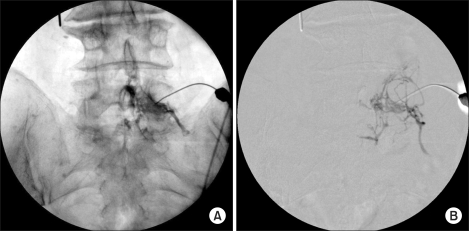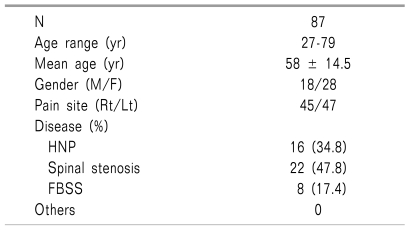1. Boswell MV, Trescot AM, Datta S, Schultz DM, Hansen HC, Abdi S, et al. Interventional techniques: evidence based practice guidelines in the management of chronic spinal pain. Pain Physician. 2007; 10:7–111. PMID:
17256025.
2. Buenaventura RM, Datta S, Abdi S, Smith HS. Systematic review of therapeutic lumbar transforaminal epidural steroid injections. Pain Physician. 2009; 12:233–251. PMID:
19165306.
3. Marshall LL, Trethewie ER, Curtain CC. Chemical radiculitis: a clinical, physiological and immunological study. Clin Orthop Relat Res. 1977; 129:61–67. PMID:
608297.
4. Wheeler AH, Murrey DB. Chronic lumbar spine and radicular pain: pathophysiology and treatment. Curr Pain Headache Rep. 2002; 6:97–105. PMID:
11872180.

5. Hadjipavlou AG, Tzermiadianos MN, Bogduk N, Zindrick MR. The pathophysiology of disc degeneration: a critical review. J Bone Joint Surg Br. 2008; 90:1261–1270. PMID:
18827232.
6. Yamashita M, Ohtori S, Koshi T, Inoue G, Yamauchi K, Suzuki M, et al. Tumor necrosis factor-alpha in the nucleus pulposus mediates radicular pain, but not increase of inflammatory peptide, associated with nerve damage in mice. Spine. 2008; 33:1836–1842. PMID:
18670336.

7. Botwin KP, Gruber RD, Bouchlas CG, Torres-Ramos FM, Freeman TL, Slaten WK. Complications of fluoroscopically guided transforaminal lumbar epidural injections. Arch Phys Med Rehabil. 2000; 81:1045–1050. PMID:
10943753.

8. Kennedy DJ, Dreyfuss P, Aprill CN, Bogduk N. Paraplegia following image-guided transforaminal lumbar spine epidural steroid injection: two case reports. Pain Med. 2009; 10:1389–1394. PMID:
19863744.

9. Bogduk N, Dreyfuss P, Baker R, Yin W, Landers M, Hammer M, et al. Complications of spinal diagnostic and treatment procedures. Pain Med. 2008; 9:S11–S34.

10. Houten JK, Errico TJ. Paraplegia after lumbosacral nerve root block: report of three cases. Spine J. 2002; 2:70–75. PMID:
14588291.
11. McLain RF, Fry M, Hecht ST. Transient paralysis associated with epidural steroid injection. J Spinal Disord. 1997; 10:441–444. PMID:
9355063.

12. Reitman CA, Watters W 3rd. Subdural hematoma after cervical epidural steroid injection. Spine. 2002; 27:E174–E176. PMID:
11884923.

13. Baker R, Dreyfuss P, Mercer S, Bogduk N. Cervical transforaminal injection of corticosteroids into a radicular artery: a possible mechanism for spinal cord injury. Pain. 2003; 103:211–215. PMID:
12749976.

14. Smuck M, Fuller BJ, Chiodo A, Benny B, Singaracharlu B, Tong H, et al. Accuracy of intermittent fluoroscopy to detect intravascular injection during transforaminal epidural injections. Spine. 2008; 33:E205–E210. PMID:
18379390.

15. Furman MB, Giovanniello MT, O'Brien EM. Incidence of intravascular penetration in transforaminal cervical epidural steroid injections. Spine. 2003; 28:21–25. PMID:
12544950.

16. Smuck M, Fuller BJ, Yoder B, Huerta J. Incidence of simultaneous epidural and vascular injection during lumbosacral transforaminal epidural injections. Spine J. 2007; 7:79–82. PMID:
17197337.

17. Jasper JF. Is digital subtraction fluoroscopy a useful tool for the interventional pain physician? Pain Physician. 2002; 5:36–39. PMID:
16896356.
18. Jasper JF. Role of digital subtraction fluoroscopic imaging in detecting intravascular injections. Pain Physician. 2003; 6:369–372. PMID:
16880884.
19. Batson OV. The vertebral vein system. Caldwell lecture, 1956. Am J Roentgenol Radium Ther Nucl Med. 1957; 78:195–212.
20. Tiso RL, Cutler T, Catania JA, Whalen K. Adverse central nervous system sequelae after selective transforaminal block: the role of corticosteroids. Spine J. 2004; 4:468–474. PMID:
15246308.

21. Breslin DS, Martin G, Macleod DB, D'ercole F, Grant SA. Central nervous system toxicity following the administration of levobupivacaine for lumbar plexus block: a report of two cases. Reg Anesth Pain Med. 2003; 28:144–147. PMID:
12677626.

22. Kim DW, Shim JC. Incidence of intravascular penetration during transforaminal lumbosacral epidural steroid injection. Korean J Pain. 2007; 20:26–30.

23. Karasek M, Bogduk N. Temporary neurologic deficit after cervical transforaminal injection of local anesthetic. Pain Med. 2004; 5:202–205. PMID:
15209975.

24. Stretanski MF, Chopko B. Unintentional vascular uptake in fluoroscopically guided, contrast confirmed spinal injections: a 1-yr clinical experience and discussion of findings. Am J Phys Med Rehabil. 2005; 84:30–35. PMID:
15632486.

25. Barbey MM, Farber A, Marienhoff N, Gmelin E. Digital subtraction angiography with carbon dioxide-basic principles, technique and clinical application. Vasa. 1999; 28:243–249. PMID:
10611841.





 PDF
PDF Citation
Citation Print
Print







 XML Download
XML Download